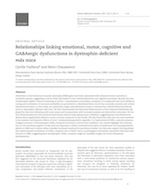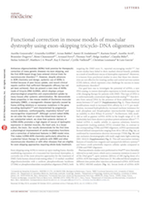Publications
Filtrer par type
Classer par date
Neurobiologie des troubles cognitifs des modèles murins de la myopathie de Duchenne

Abstract
La dystrophie musculaire de Duchenne (DMD) est un syndrome neuromusculaire dû à des mutations dans le gène dmd qui conduisent à la perte d’expression des dystrophines, protéines normalement exprimée dans différents tissus y compris le cerveau. Le profil cognitif des patients est hétérogène et la présence d’une déficience intellectuelle dépend de la position des mutations dans le gène. Cette variabilité s’explique par la complexité du gène dmd qui comprend plusieurs promoteurs internes permettant l’expression cérébrale de plusieurs dystrophines de tailles différentes. Dans ce travail de thèse, nous nous sommes intéressés à deux dystrophines : la dystrophine complète (Dp427), normalement exprimée dans le muscle et le cerveau et absente chez tous les patients DMD, et la forme la plus courte de dystrophine, la Dp71, produit cérébral majeur du gène dmd absente dans un sous-groupe de patients. Ces deux dystrophines ont des fonctions cellulaires différentes : La Dp427, normalement exprimée dans les synapses inhibitrices en interaction avec les récepteurs du GABA, joue un rôle dans la plasticité synaptique, l’apprentissage et la mémoire. Sa perte conduit à des déficits cognitifs modérés. La Dp71, majoritairement exprimée dans les astrocytes périvasculaires, contribue à l’ancrage de canaux ioniques impliqués dans l’homéostasie cérébrale et joue aussi un rôle dans la synapse glutamatergique. La perte de Dp71 aggrave fortement les déficits associés à la perte de Dp427 chez les patients et conduit à une déficience intellectuelle sévère. Les relations génotypes-phénotypes restent à préciser et on suppose qu’au-delà de la sévérité des déficits, la nature même des altérations cognitives, ainsi que que la présence de troubles sensoriels, cognitifs, exécutifs et neuropsychiatriques, dépendent des formes de dystrophines touchées. Pour étudier le rôle de ces deux dystrophines, nous avons utilisé deux modèles murins : la souris mdx uniquement déficiente en Dp427, et la souris Dp71-null uniquement déficiente en Dp71. Une étude comportementale à large spectre nous a permis de mieux caractériser le phénotype associé à la perte de Dp427 et de Dp71, en précisant l’intégrité de la perception et du traitement des stimuli sensoriels auditifs, des réponses émotionnelles et de la réactivité au stress, des performances d’apprentissage, ainsi que de certaines composantes des fonctions exécutives, comme la mémoire de travail spatiale et la flexibilité comportementale. Ce travail a été complété par des études collaboratives visant à caractériser le rôle de la Dp71 dans la plasticité corticale et à développer une approche de thérapie génique pour restaurer la fonction de la Dp427 chez la souris mdx. Nous montrons que la perte de Dp427 perturbe les fonctions GABAergiques, les réponses émotionnelles induites par un stress ainsi que la mémoire émotionnelle et la mémoire à long terme, sans altération majeure des fonctions sensorielles et exécutives. Nous montrons aussi qu’une thérapie génique basée sur des injections systémiques d’oligonucléotides antisens, porteurs de chimies spécifiques et passant la barrière hémato-encéphalique, est capable de restaurer une Dp427 fonctionnelle par la technique du saut d’exon et de compenser les altérations émotionnelles des souris mdx. La perte de Dp71 a un impact différent : Elle altère la balance excitation/inhibition et la plasticité synaptique corticale et perturbe l’apprentissage, la flexibilité comportementale et la mémoire de travail dans des tâches d’apprentissage spatial. Notre étude de ces modèles murins a donc permis de clarifier les relations génotype-phénotype et les bases neurobiologiques de cette maladie, et d’identifier des phénotypes utiles pour valider l’efficacité de traitements ciblant le cerveau dans des études précliniques.
Relationships linking emotional, motor, cognitive and GABAergic dysfunctions in dystrophin-deficient mdx mice

Abstract
Alterations in the Duchenne muscular dystrophy (DMD) gene have been associated with enhanced stress reactivity in vertebrate species, suggesting a role for brain dystrophin in fear-related behavioral and cognitive processes. Because the loss of dystrophin (Dp427) reduces clustering of central γ-aminobutyric acid (GABAA) receptors, it is suspected that local inhibitory tuning and modulation of neuronal excitability are perturbed in a distributed brain circuit that normally controls such critical behavioral functions. In this study, we undertook a large-scale behavioral study to evaluate fear-related behavioral disturbances in dystrophin-deficient mdx mice. We first characterized the behavioral determinants of the enhanced fearfulness displayed by mdx mice following mild acute stress and its association with increased anxiety and altered fear memories. We further demonstrated that this enhanced fearfulness induces long-lasting motor inhibition, suggesting that neurobehavioral dysfunctions significantly influence motor outcome measures in this model. We also found that mdx mice are more sensitive to the sedative and hypnotic effects of 4,5,6,7-tetrahydroisoxazolo[5,4-c]pyridin-3-ol hydrochlorid (THIP), a selective pharmacological activator of extrasynaptic GABAA receptors involved in central tonic inhibition. Our results highlight that information on the emotional aspects of mdx mice are important to better understand the bases of intellectual and neuropsychiatric defects in DMD and to better define valuable functional readouts for preclinical studies. Our data also support the hypothesis that altered spatial localization of GABAA receptors due to Dp427 loss is a pathological mechanism associated with brain dysfunction in DMD, suggesting that extrasynaptic GABAA receptors might be candidate targets for future therapeutic developments.
Cognitive dysfunction in the dystrophin-deficient mouse model of Duchenne muscular dystrophy: A reappraisal from sensory to executive processes

Abstract
Duchenne muscular dystrophy (DMD) is associated with language disabilities and deficits in learning and memory, leading to intellectual disability in a patient subpopulation. Recent studies suggest the presence of broader deficits affecting information processing, short-term memory and executive functions. While the absence of the full-length dystrophin (Dp427) is a common feature in all patients, variable mutation profiles may additionally alter distinct dystrophin-gene products encoded by separate promoters. However, the nature of the cognitive dysfunctions specifically associated with the loss of distinct brain dystrophins is unclear. Here we show that the loss of the full-length brain dystrophin in mdx mice does not modify the perception and sensorimotor gating of auditory inputs, as assessed using auditory brainstem recordings and prepulse inhibition of startle reflex. In contrast, both acquisition and long-term retention of cued and trace fear memories were impaired in mdx mice, suggesting alteration in a functional circuit including the amygdala. Spatial learning in the water maze revealed reduced path efficiency, suggesting qualitative alteration in mdx mice learning strategy. However, spatial working memory performance and cognitive flexibility challenged in various behavioral paradigms in water and radial-arm mazes were unimpaired. The full-length brain dystrophin therefore appears to play a role during acquisition of associative learning as well as in general processes involved in memory consolidation, but no overt involvement in working memory and/or executive functions could be demonstrated in spatial learning tasks.
Functional correction in mouse models of muscular dystrophy using exon-skipping tricyclo-DNA oligomers

Abstract
Antisense oligonucleotides (AONs) hold promise for therapeutic correction of many genetic diseases via exon skipping, and the first AON-based drugs have entered clinical trials for neuromuscular disorders. However, despite advances in AON chemistry and design, systemic use of AONs is limited because of poor tissue uptake, and recent clinical reports confirm that sufficient therapeutic efficacy has not yet been achieved. Here we present a new class of AONs made of tricyclo-DNA (tcDNA), which displays unique pharmacological properties and unprecedented uptake by many tissues after systemic administration. We demonstrate these properties in two mouse models of Duchenne muscular dystrophy (DMD), a neurogenetic disease typically caused by frame-shifting deletions or nonsense mutations in the gene encoding dystrophin and characterized by progressive muscle weakness, cardiomyopathy, respiratory failure and neurocognitive impairment. Although current naked AONs do not enter the heart or cross the blood-brain barrier to any substantial extent, we show that systemic delivery of tcDNA-AONs promotes a high degree of rescue of dystrophin expression in skeletal muscles, the heart and, to a lesser extent, the brain. Our results demonstrate for the first time a physiological improvement of cardio-respiratory functions and a correction of behavioral features in DMD model mice. This makes tcDNA-AON chemistry particularly attractive as a potential future therapy for patients with DMD and other neuromuscular disorders or with other diseases that are eligible for exon-skipping approaches requiring whole-body treatment.
Cerebellar synapse properties and cerebellum-dependent motor and non-motor performance in Dp71-null mice
Abstract
A recent focus has been placed on the role that cerebellar dysfunctions could play in the genesis of cognitive deficits in Duchenne muscular dystrophy (DMD). However, relevant genotype-phenotype analyses are missing to define whether cerebellar defects underlie the severe cases of intellectual deficiency, which have been associated with genetic loss of the smallest product of the dmd gene, the Dp71 dystrophin. To determine for the first time whether Dp71 loss could affect cerebellar physiology and functions, we have used patch-clamp electrophysiological recordings in acute cerebellar slices and a cerebellum-dependent behavioral test battery addressing cerebellum-dependent motor and non-motor functions in Dp71-null transgenic mice. We found that Dp71 deficiency selectively enhances excitatory transmission at glutamatergic synapses formed by climbing fibers (CFs) on Purkinje neurons, but not at those formed by parallel fibers (PFs). Altered basal neurotransmission at CFs was associated with impairments in synaptic plasticity and clustering of the scaffolding post-synaptic density protein PSD-95. At the behavioral level, Dp71-null mice showed some improvements in motor coordination and were unimpaired for muscle force, static and dynamic equilibrium, motivation in high-motor demand and synchronization learning. However, Dp71-null mice displayed altered strategies in goal-oriented navigation tasks, suggesting a deficit in the cerebellum-dependent processing of the procedural components of spatial learning which could contribute to the visuo-spatial deficits identified in this model. In all, the observed deficits suggest that Dp71 loss alters cerebellar synapse function and cerebellum-dependent navigation strategies without being detrimental for motor functions.
Dp71-dystrophin deficiency alters prefrontal cortex excitation-inhibition balance and executive functions
Abstract
In the Duchenne muscular dystrophy (DMD) syndrome, mutations affecting expression of Dp71, the main dystrophin isoform of the multipromoter dmd gene in brain, have been associated with intellectual disability and neuropsychiatric disturbances. Patients’ profile suggests alterations in prefrontal cortex-dependent executive processes, but the specific dysfunctions due to Dp71 deficiency are unclear. Dp71 is involved in brain ion homeostasis, and its deficiency is expected to increase neuronal excitability, which might compromise the integrity of neuronal networks undertaking high-order cognitive functions. Here, we used electrophysiological (patch clamp) and behavioral techniques in a transgenic mouse that display a selective loss of Dp71 and no muscular dystrophy, to identify changes in prefrontal cortex excitatory/inhibitory (E/I) balance and putative executive dysfunctions. We found prefrontal cortex E/I balance is shifted toward enhanced excitation in Dp71-null mice. This is associated with a selective alteration of AMPA receptor-mediated glutamatergic transmission and reduced synaptic plasticity, while inhibitory transmission is unaffected. Moreover, Dp71-null mice display deficits in cognitive processes that depend on prefrontal cortex integrity, such as cognitive flexibility and sensitivity of spatial working memory to proactive interference. Our data suggest that impaired cortical E/I balance and executive dysfunctions contribute to the intellectual and behavioral disturbances associated with Dp71 deficiency in DMD, in line with current neurobehavioral models considering these functions as key pathophysiological factors in various neurodevelopmental disorders. These new insights in DMD neurobiology also suggest new directions for therapeutic developments targeting excitatory neurotransmission, as well as for guidance of academic environment in severely affected DMD children.
A multi-scale analysis in CD38-/- mice unveils major prefrontal cortex dysfunctions
Abstract
Autism spectrum disorder (ASD) is characterized by early onset of behavioral and cognitive alterations. Low plasma levels of oxytocin (OT) have also been found in ASD patients; recently, a critical role for the enzyme CD38 in the regulation of OT release was demonstrated. CD38 is important in regulating several Ca2+-dependent pathways, but beyond its role in regulating OT secretion, it is not known whether a deficit in CD38 expression leads to functional modifications of the prefrontal cortex (PFC), a structure involved in social behavior. Here, we report that CD38-/- male mice show an abnormal cortex development, an excitation-inhibition balance shifted toward a higher excitation, and impaired synaptic plasticity in the PFC such as those observed in various mouse models of ASD. We also show that a lack of CD38 alters social behavior and emotional responses. Finally, examining neuromodulators known to control behavioral flexibility, we found elevated monoamine levels in the PFC of CD38-/- adult mice. Overall, our study unveiled major changes in PFC physiologic mechanisms and provides new evidence that the CD38-/- mouse could be a relevant model to study pathophysiological brain mechanisms of mental disorders such as ASD.